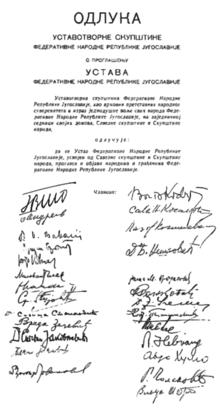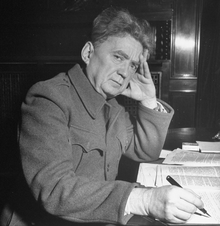1946 Yugoslav Constitution
Since opposition parties were suppressed, electoral list of PFY won an overwhelming electoral victory, thus allowing CPY to proceed with its plans for definite abolition of the already weakened monarchy.
[5][3] Constitution has defined Yugoslavia as a people's republic, and a federation (Article 1), thus finalizing two main political goals of the People's Front of Yugoslavia (PFY), and the ruling Communist Party of Yugoslavia (CPY), led by Josip Broz Tito, at that time President of the Yugoslav Government.
Equality of all citizens and all groups was proclaimed and guarantied, but not a single nationality or ethnicity was mentioned by name in the entire text of the Constitution.
Distribution of power was based on the principle of "democratic centralism", which was defined by the leading Yugoslav constitutional ideologue of that time: Edvard Kardelj.
After the conflict with the Soviet Union broke out in 1948, Yugoslav authorities decided to find their own way to socialism.
In his address to the Fifth Congress (1948) of the Communist Party of Yugoslavia, general secretary Josip Broz Tito referred to several articles of the Constitution to demonstrate its liberal nature.


